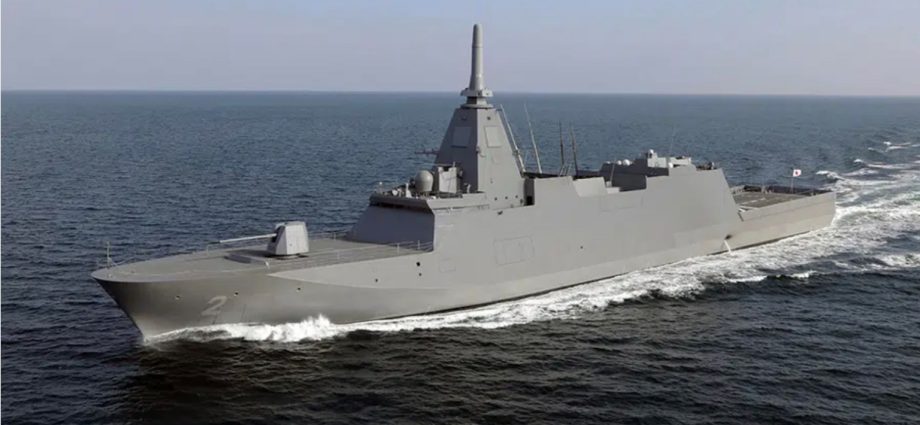Japan plans to build a follow-on class to its Mogami-class frigates, which are seemingly inadequate to counter China’s growing naval presence in the Pacific and North Korea’s evolving missile threats.
Naval News reported that the Japanese Ministry of Defense’s Acquisition, Technology, and Logistics (ATLA) signed separate contracts in March with Mitsubishi Heavy Industries (MHI) and Japan Maritime United (JMU) to build a successor to the Mogami-class frigates.
The report notes that MHI was awarded a 15.4 million yen (US$111.8 million) contract while JMU won a 14.96 million yen contract to conduct studies on the future frigate, with August 31 this year the given deadline for proposed designs.
Naval News notes that the Japan Maritime Self-Defense Force (JMSDF) originally planned to buy 22 Mogami-class frigates, with a production rate of two ships per year.
Naval Technology notes in an August 2021 article that the Mogami-class is built to improve the JMSDF’s capability to patrol its extensive Exclusive Economic Zone (EEZ), strengthen its deterrent posture and respond to various situations, as well as provide multi-mission capabilities. The report also notes that the Mogami-class is set to replace the JMSDF’s aging Asagiri-class and Abukuma-class destroyers.
Japan Times notes in a March 2023 article that the Mogami-class is difficult to detect by radar due to its stealth hull shaping and can perform various missions such as warning and surveillance, anti-air, anti-surface, anti-submarine and minesweeping operations. The report also mentions that it was designed to be cheaper to build than large destroyers while having less than half the manpower required to operate.
However, the Mogami-class may have been a product of several design compromises. Meta-Defense notes in an article this month that the Mogami-class design was dictated by economic, manpower and financial factors, which ultimately determined its capabilities.
Meta-Defense says that the 4,000-ton ships cost 50 billion yen each, an amount more commonly encountered in corvettes half the size of first-class frigates.
The report notes that the frigates are well-equipped and capable with OPY-3 2D radar including active electronically scanned array (AESA) antennas, 16-round Mk41 vertical launching systems (VLS), eight Type 17 anti-ship missiles, a RIM-116 SeaRAM close-in weapons system (CIWS) and a 45mm Mk4 Mod 127 gun.
The report also notes that the class has substantial anti-submarine capabilities, including hull sonar, variable depth sonar, an SH-60L naval helicopter and Type 12 torpedoes. On top of those anti-submarine systems, Takahashi Kosuke notes in an April 2022 article in The Diplomat that the Mogami-class features the first unmanned underwater vehicle (UUV) and an unmanned surface vehicle (USV) aboard a Japanese frigate.
In terms of crew size, Naval News also mentions that the Mogami-class has a 90-strong crew, less than half the 220 men required for the Asagiri-class destroyer. The lack of sufficient personnel has been a long-standing issue in the Japanese Self-Defense Forces (JSDF).

Thomas Newdick notes in a September 2022 article in The Warzone that acute personnel shortages have limited the number of trained crews to run the JMSDF’s warships, with the problems so pronounced that the Mogami-class may have to take on roles traditionally assigned to larger destroyers, albeit being less capable warships.
Naval News notes several issues that led to the early discontinuation of the Mogami-class in favor of a more advanced follow-on, citing problems such as the layout of the equipment room and mooring capstans.
Sebastien Robin notes in a March 2021 Forbes article that Mogami-class frigates also have limited air defense capabilities with just one RIM-116 SeaRAM teamed with short-range guns that have a short 9.6-kilometer range.
Moreover, Robin mentions that the Mogami-class was built to accommodate 16 vertical launch cells that can carry longer-range missiles, although the two lead ships were delivered without the launchers installed.
The design compromise, Robin says, means that the ships do not contribute meaningfully to fleet air defense and are unable to thin out an incoming air and missile attack from afar.
However, he notes that these ships are to be upgraded with MK 41 launchers loaded with US RIM-162 Evolved Sea Sparrow Missiles or the locally-built Type 03 Chu medium-range surface-to-air missiles, as well as Type 07 anti-submarine missiles.
Robin mentions that while those missiles have ranges of over 48 kilometers, the upgraded Mogami frigates will still rely on Japan’s Aegis destroyers for better radar coverage.
These issues may tie into Japan’s more significant problems in building its fleet to counter an increasingly more assertive China and an ever-more belligerent North Korea.
Tim Fish notes in an April 2022 article for USNI News that Japan can only outpace China regarding naval shipbuilding by substantially increasing its defense budget, which he suggests may not be politically feasible.
Fish says Japan must accept secondary naval power status in Northeast Asia, although it has access to the latest technology to improve its fleet qualitatively. He says Tokyo runs the risk of believing quality can ultimately make up for a lack of quantity and actual physical presence vis-à-vis China.

He also says that North Korea’s improving missile capabilities make it imperative for Japan to toughen its sea-based missile defenses, noting that international efforts to limit Pyongyang’s missile program through diplomacy and sanctions have not worked.
Despite being the subject of crushing sanctions, North Korea has continued to improve its missile technology through the development of hypersonic weapons, solid-fuel rockets and submarine-launched ballistic missiles (SLBM).
North Korea’s missile development highlights the importance of the JMSDF’s missile defense and anti-submarine warfare capabilities, underscoring the need for larger, more capable ships despite a looming manpower shortage.

